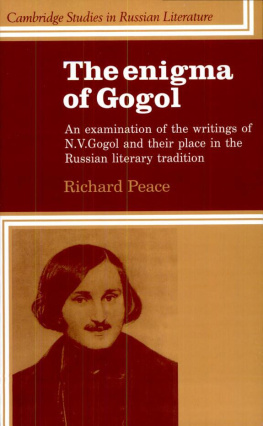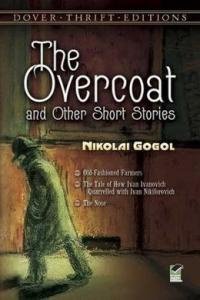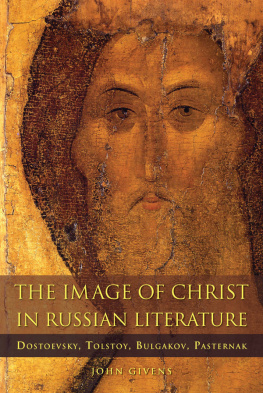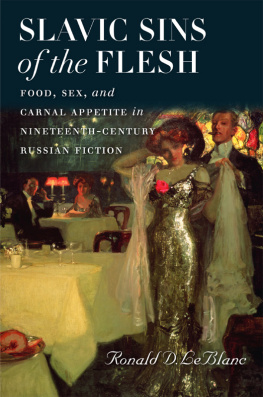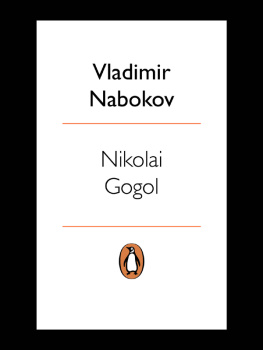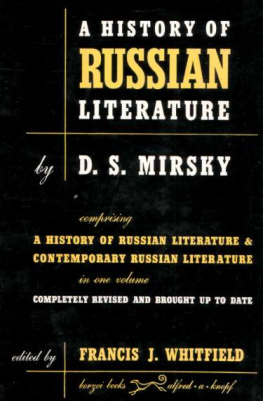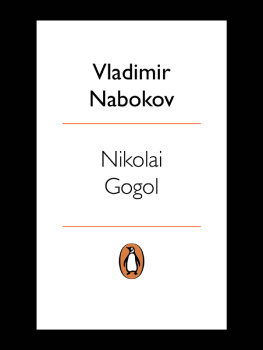To the memory of Henry Peace
Preface - page vii
Introduction: Gogol and Russian humanism - 1
Evenings in a village near Dikanka - 12
I Mirgorod - 28
Origins and aims - 28
The Old World Landowners - 31
Taras Bulba - 47
Viy - 53
The tale of how Ivan Ivanovich quarrelled with Ivan Nikiforovich - 74
Mirgorod as a cycle - 89
II The St Petersburg Tales - 94
The Nevsky Prospekt - 95
The Portrait - 112
The Diary of a Madman - 124
The Nose - 130
The Overcoat - 141
III Theatre - 151
The Government Inspector: characters and themes - 151
The Government Inspector: comedy, construction, devices - 172
Marriage: a completely improbable event in two acts - 192
IV The Carriage and Rome - 206
The Carriage (Calash) - 206
Rome - 211
V Dead Souls - 213
The gallery of portraits - 213
Negative types : positive ideals - 234
The poem in prose - 249
Social satire and comic devices - 263
Author, reader, hero - 273
Conclusion. Art is a reconciliation with life - 282
Appendix A. Rank in Gogols Russia - 300
Appendix B. The writing of The Nose - 302
Preface
In Moscow there are two statues of Gogol a very short distance apart. One is an upright figure smiling confidently on the world : the Happy Gogol (Gogol veselyy). The other depicts the writer seated, surrounded by characters from his works-it is the Sad Gogol (Gogolgrustnyy), and yet, looked at from certain angles, it is also a sly Gogol. The Happy Gogol stands at the head of the boulevard which bears the writers name, and was erected at the centenary of his death to replace the Sad Gogol, which was relegated to a quiet square on the other side of what is now the Kalininsky Prospekt.
That there should be two Gogols (even three - or more) will come as no surprise to those who know his works. Thus three recent studies have examined his writing from distinct points of view. Simon Karlinsky (The sexual labyrinth of Nikolai Gogol) has seen homosexuality as the great key. Donald Fnger (The creation of Nikolai Gogol) concentrates more on stylistic considerations, and sees the medium itself as the message, whereas James Woodward (Gogols Dead Souls) interprets the writers major work as a system of arcane symbols.
I would argue that the neurotic preoccupations of Gogols artistic personality are not exclusively homosexual, nor even exclusively sexual. On the other hand, self-sufficiency of style is a doubtful concept - above all for a writer so far removed from the canons of polished elegance. Although symbolism plays an important role in Gogols writing, he is not the builder of an intricately coherent symbolic universe. Gogols artistic concerns are rather with disparity and incongruity. In the present study I have attempted to avoid critical monotheism, but inevitably certain concepts will recur. As well as analysing the texts themselves I have sought to relate them to the tradition of Russian literature which Gogol inherited, and also to point to the rich legacy they represent for those who came after.
I wish to express my gratitude to the editorial board of the Slavonic and East European Review for allowing me to reprint an edited and slightly rewritten version of my article on The Old World Landowners which first appeared there. Other articles have appeared in Russian and Slavic Literature (Slavica), Filoloski Pregled (Belgrade), the Oxford Slavonic Papers and as contributions to Exeter Tapes, but although, inevitably, there are similarities of approach and argument these articles are distinct from the corresponding sections of the present study and have been fully acknowledged in the notes. I am particularly grateful to Henry Gifford for his keen critical eye and for his many helpful suggestions. I also wish to thank John Bernasconi for advice on artistic matters, and members of the Department of Russian Studies at Hull University, in particular Dr Elizabeth Warner for allowing me to quote from her study on the Russian Folk Theatre and for her advice on Russian folklore in general, also Dr Edmund Little, who has his own scholarly interest in Gogol. I owe a special debt of gratitude to the Departmental secretaries, Sheena and Tanya, for their unstinting work in typing the manuscript, and I also wish to acknowledge the help given by the editorial staff of Cambridge University Press.
Hull RICHARD PEACE
June 1981
A note on transliteration
For the convenience of non-specialist readers, proper names in the main text are rendered in the simplified form of the British system, familiar to readers of Russian literature in translation. However the demands of phonetic exactitude necessitate the use of the orthodox British system in quoted matter.
Introduction
Gogol and Russian humanism
Gogols contemporaries and later biographers largely agree on one fact: the enigma of his personality. Enigma, too, inheres in his writing, so that both his life and works have given rise to many misunderstandings and been the subject of widely divergent interpretations. Gogol himself frequently complained of being misunderstood, but, by and large, his attempts at elucidation have merely deepened the mystery.
To many modern Western critics his immense reputation throughout the nineteenth century as a realist writer seems in itself to be based on a misconception.1 Nevertheless one fact is undeniable: Gogol exerted an immense influence on the whole course of Russian literature and continues to do so to the present day. There is scarcely a later Russian writer who did not succumb in some measure to his magic, and in many cases (Dostoevsky, Chekhov, Ilf and Petrov) his influence was crucial. In this sense alone, to call Gogol the father of Russian prose fiction is eminently justifiable.
Yet at once we come up against the Gogolian enigma. The Russian prose tradition is outstanding in its psychological analysis and insight: Gogol apparently shuns any inner exploration of his characters. The Russian tradition is realism: Gogols world is permeated by the grotesque. The Russian tradition is largely built on powerful yet simple prose (Turgenev, Tolstoy, Chekhov): Gogols style is rhetorical, syntactically involved, and full of words which are not standard literary Russian. How is it that this idiosyncratic and apparently eccentric writer could have wielded such enormous literary influence?
Gogols apparent lack of interest in psychological analysis raises a more fundamental problem. Russian literature of the nineteenth century is remarkable for its depth of human understanding and compassion, yet it is precisely this which appears to be lacking in the works of Gogol. His characters seem for the most part subhuman; it is not often that the author arouses sympathy for them in his reader.
Until the nineteenth century there was no humanist tradition in Russian literature (although there are strong glimmerings at the end of the eighteenth century). Russia had not experienced the Renaissance. There had been no Russian Shakespeare or Montaigne to proclaim the richness and complexity of the human personality and its superiority to the rigid abstractions of medieval dogma. In Russia the spirit of medieval Christendom reigned a long time. Literature was principally concerned to record events and miracles (in the Chronicles or the Lives of the Saints). Its protagonists were not ordinary human beings, but exemplars of a caste: princes, heroes, saints; and the same is true of the oral tradition: the heroes of the
Next page
